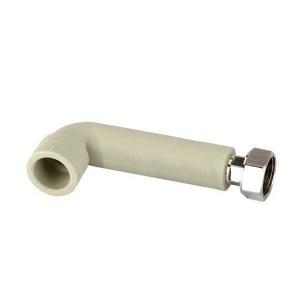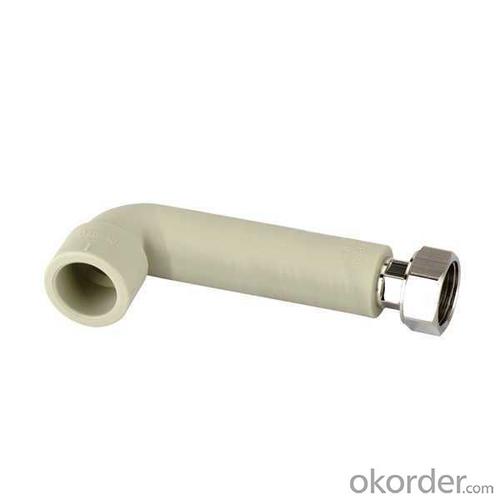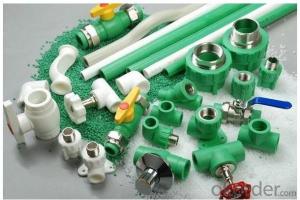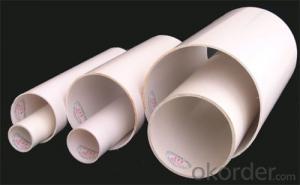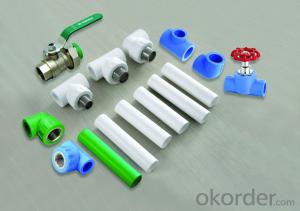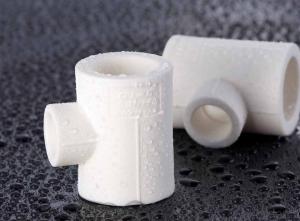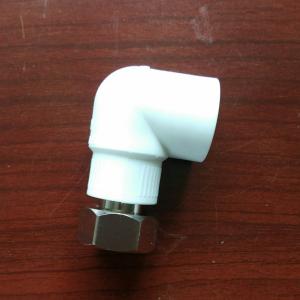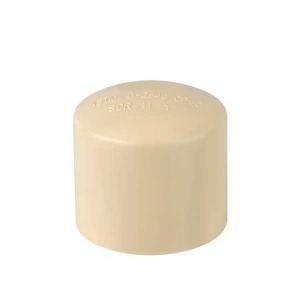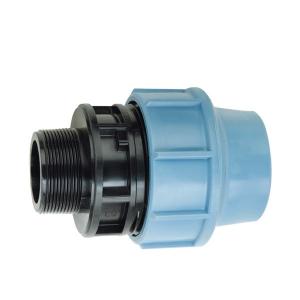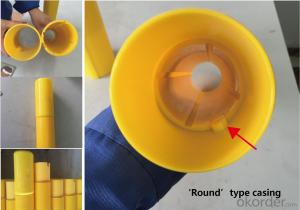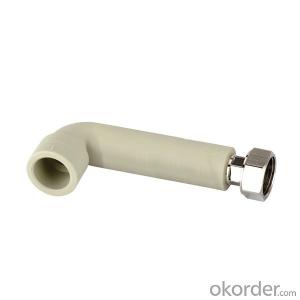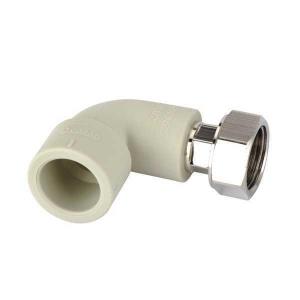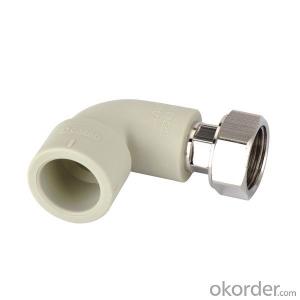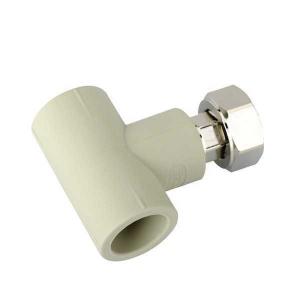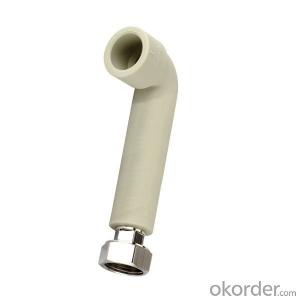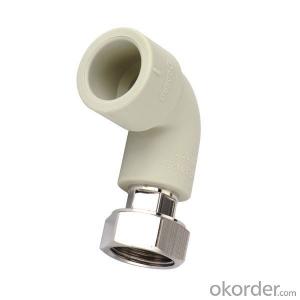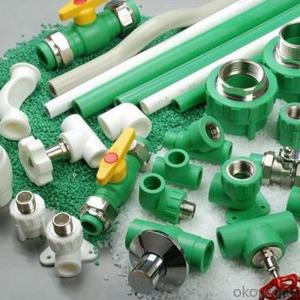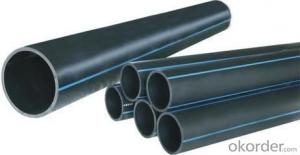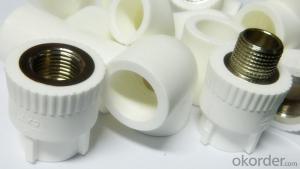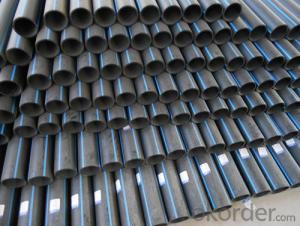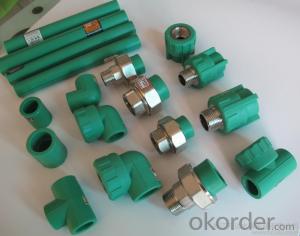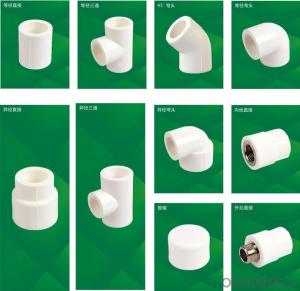Plastic Coil Pipe Fittings - High Quality Threaded Union with Long Elbow for Water Heater
- Loading Port:
- Ningbo
- Payment Terms:
- TT or LC
- Min Order Qty:
- 1000 watt
- Supply Capability:
- 100000 watt/month
OKorder Service Pledge
Quality Product, Order Online Tracking, Timely Delivery
OKorder Financial Service
Credit Rating, Credit Services, Credit Purchasing
You Might Also Like
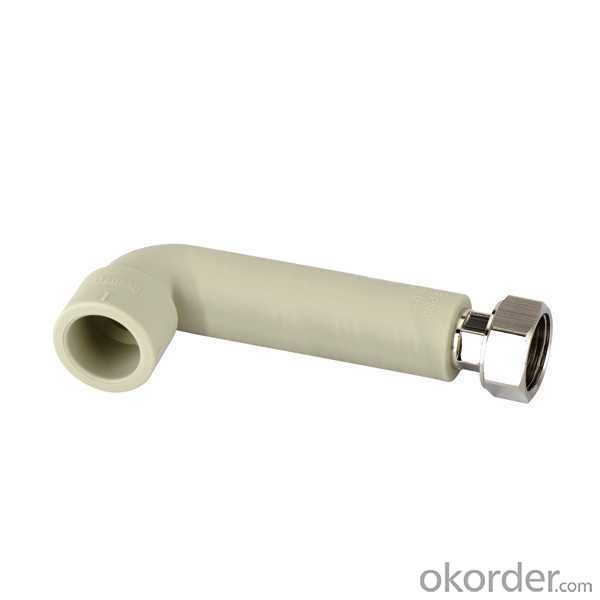 ppr fittings HYOSUNG PPR raw materials standard:DIN8077-8078 GB/T18742.3-2002 PN25 White grey green color
ppr fittings HYOSUNG PPR raw materials standard:DIN8077-8078 GB/T18742.3-2002 PN25 White grey green color
1.Material:Random Polypropylene(Hyosung R200P);
2.ISO9001&ISO14001;
3.Standard:GB/T 18742.3-2002, DIN8077/8078;
4.OEM also ok
- Q: How do plastic pipe fittings compare to fiberglass fittings?
- Plastic pipe fittings are generally more affordable and widely available compared to fiberglass fittings. However, fiberglass fittings are known for their superior strength, durability, and resistance to corrosion, making them suitable for high-pressure and corrosive applications. Additionally, fiberglass fittings offer better thermal and electrical insulation properties. Ultimately, the choice between plastic and fiberglass fittings depends on the specific requirements of the project and the desired level of performance.
- Q: Are plastic pipe fittings suitable for pneumatic conveying systems?
- Yes, plastic pipe fittings are suitable for pneumatic conveying systems. They offer several advantages such as corrosion resistance, lightweight construction, ease of installation, and flexibility. Additionally, plastic fittings can handle the high pressures and abrasive materials commonly found in pneumatic conveying systems.
- Q: Can plastic pipe fittings be used for sewer and wastewater systems?
- Yes, plastic pipe fittings can be used for sewer and wastewater systems. Plastic fittings, such as PVC or ABS, are commonly used in these systems due to their durability, corrosion resistance, and ease of installation. They are also cost-effective alternatives to traditional metal fittings. However, it is important to ensure that the plastic fittings meet the necessary standards and regulations for sewer and wastewater applications.
- Q: How do you measure plastic pipe fittings?
- To measure plastic pipe fittings accurately, you should use a measuring tape or a caliper. Start by measuring the outer diameter of the pipe fitting, which is the distance across the widest point. Additionally, measure the inner diameter, which is the distance across the narrowest point. These measurements will help you determine the correct size and type of plastic pipe fitting needed for your project.
- Q: Doubts about the connection of plastic pipe and steel pipe flange
- Pipe diameter is GB, such as DN100, DN150 and so on, the path is the sameBut the pipe will vary with the material used and the thickness of the materialBut the flange is the samePlastic pipes are the same size as flanges used in steel pipesWhen you refer to the piping design manual and the hardware manual on the plumbing and flanges, you'll see
- Q: What are the disadvantages of using plastic pipe fittings?
- One disadvantage of using plastic pipe fittings is that they may not be as durable or long-lasting as fittings made from other materials such as metal. Plastic fittings are more prone to cracking, breaking, or wearing down over time, especially when exposed to extreme temperatures or heavy pressure. Additionally, plastic fittings may not be suitable for certain applications that require higher strength or resistance to chemicals.
- Q: Can plastic pipe fittings be used in sewage treatment systems?
- Yes, plastic pipe fittings can be used in sewage treatment systems. Plastic fittings are commonly used in sewage treatment systems due to their corrosion resistance, durability, and cost-effectiveness. They are often preferred over traditional metal fittings as they do not rust or corrode, making them suitable for the harsh and corrosive environment of sewage treatment systems.
- Q: Can plastic pipe fittings be used for solar water heating systems?
- Yes, plastic pipe fittings can be used for solar water heating systems. Plastic fittings are commonly used in these systems due to their corrosion resistance, affordability, and ease of installation. However, it is important to select fittings that are specifically designed for high-temperature applications to ensure durability and longevity.
- Q: Are plastic pipe fittings suitable for all types of pipes?
- No, plastic pipe fittings are not suitable for all types of pipes. Different types of pipes, such as copper, PVC, or steel, may require specific fittings designed for their material and connection method. It is important to ensure compatibility and use the appropriate fittings for each pipe type to ensure a secure and leak-free connection.
- Q: How do you prevent leaks in plastic pipe fittings?
- One way to prevent leaks in plastic pipe fittings is to ensure a proper and secure connection. This can be achieved by using the correct size and type of fittings for the specific application, and following the manufacturer's instructions for installation. Additionally, it is important to use appropriate tools and techniques to tighten the fittings adequately without over-tightening, as excessive force can cause damage and lead to leaks. Regular inspections and maintenance, such as checking for signs of wear or damage, can also help identify potential leaks and prevent them from occurring.
Send your message to us
Plastic Coil Pipe Fittings - High Quality Threaded Union with Long Elbow for Water Heater
- Loading Port:
- Ningbo
- Payment Terms:
- TT or LC
- Min Order Qty:
- 1000 watt
- Supply Capability:
- 100000 watt/month
OKorder Service Pledge
Quality Product, Order Online Tracking, Timely Delivery
OKorder Financial Service
Credit Rating, Credit Services, Credit Purchasing
Similar products
Hot products
Hot Searches
Related keywords
